[ Home TNT-Audio | Staff & Contacts | HiFi Playground | Listening tests | DIY & Tweakings | Music & Books ]
Monacor DT-99 and dt300 Tweeters: Modifications and Waveguides
Nice Tweeters for DIY Loudspeakers
[Italian version here]
Author: Paul Hunting - TNT UK
Manufacturer: Monacor - Germany
Published: September, 2023
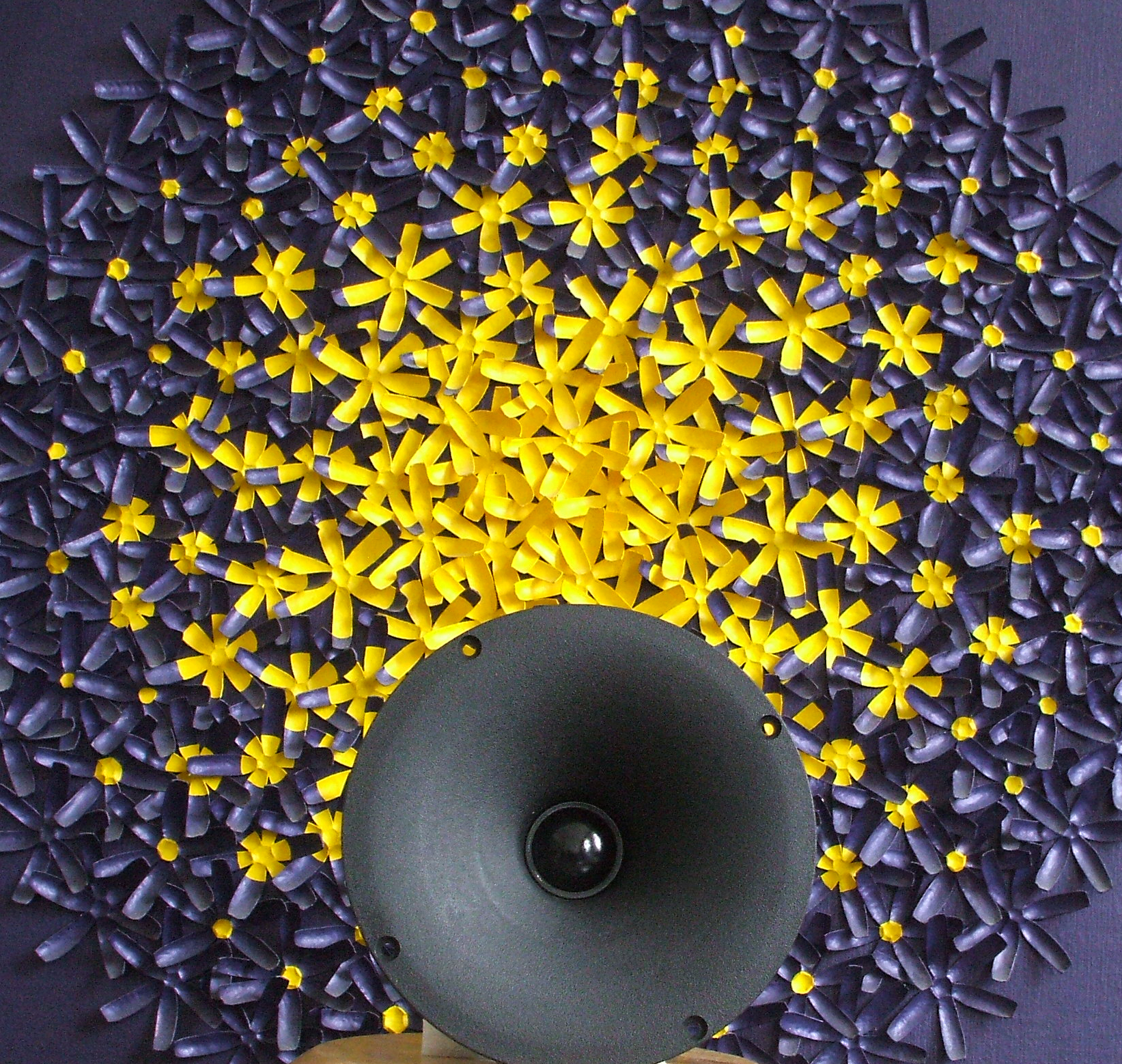
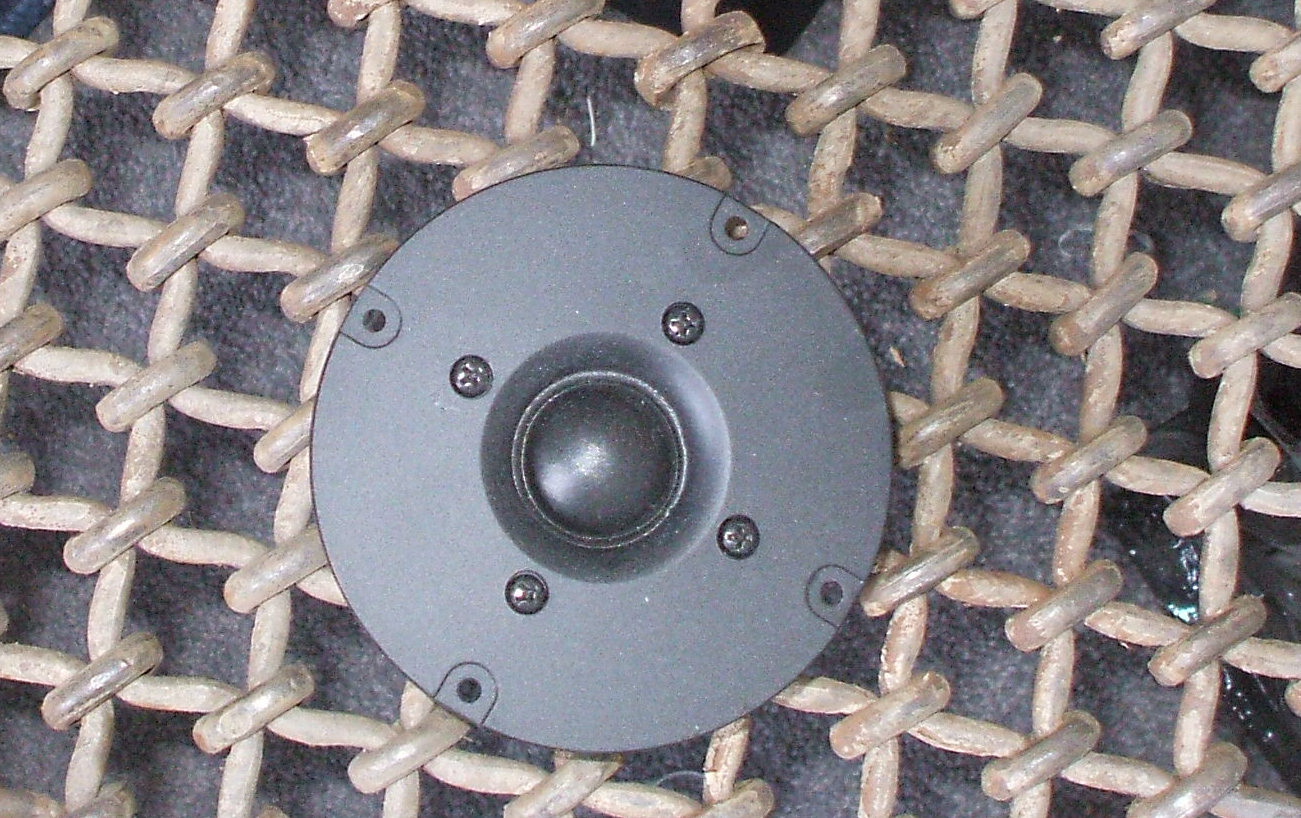
Monacor tweeter Artwork by Ida Ivanka Kubler
Introduction
The DT-99 is a nominal 8 ohm, silk dome tweeter with a resonant frequency of 1,500Hz, Monacor recommends a second order crossover at 2,500Hz and says that the tweeter should be good for frequencies up to 18kHz. The DT-300 is also an 8 ohm silk dome tweeter, has a lower resonant frequency of 900Hz, a recommended crossover of 2,000Hz and is for frequencies up to 19kHz. Both use ferro fluid immersed voice coils and have voice coils of a similar size.
An interesting development, at least for DIYers, has been the websites publishing metrics on drivers. For example Troels Gravesen, Audioxpress, and Speakerdesign. The Dibirama website publishes test measurements on both drivers; the DT-99 and the DT-300. Using charts from the same testing facility will minimise measurement difference as a result of placement, sound pressure (SPL) levels, gear, and background noise. The following chart comparisons are taken from the Dibirama website.
Total Harmonic Distortion
Figure 1 THD % at three volumes, 90dB, 96dB and 102dB for two Monacor tweeter drivers DT-309 DT-99
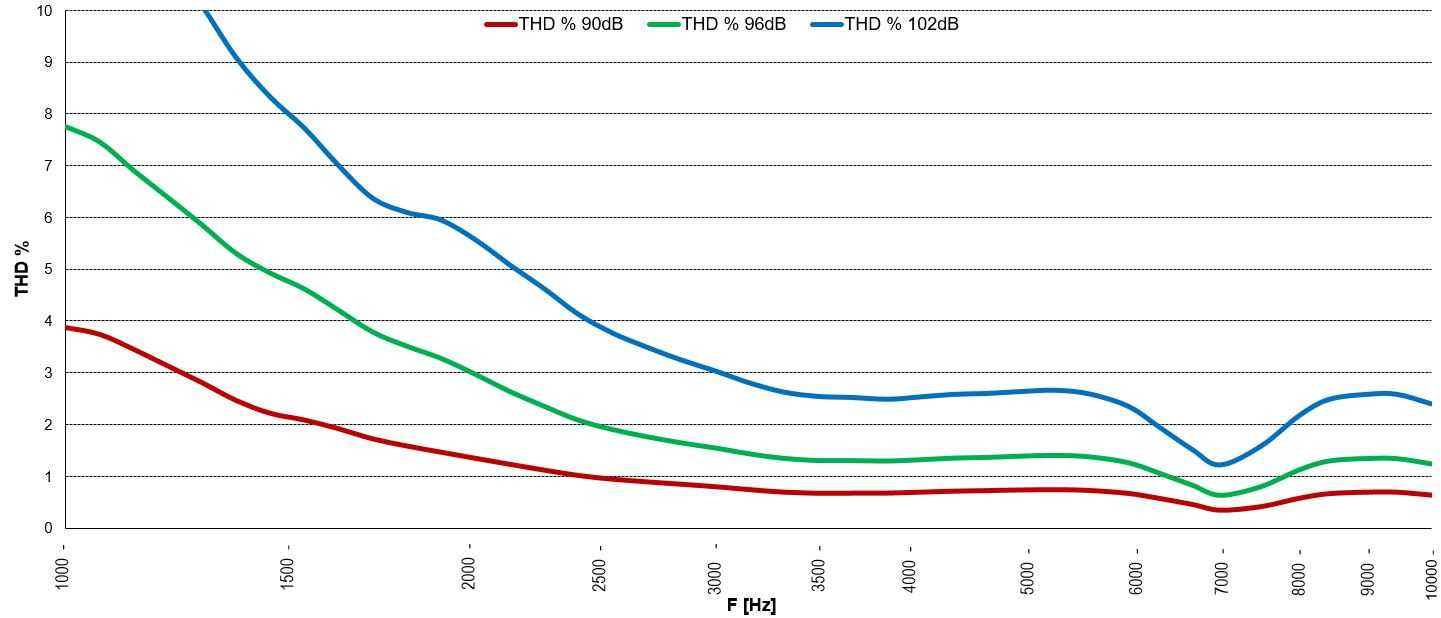
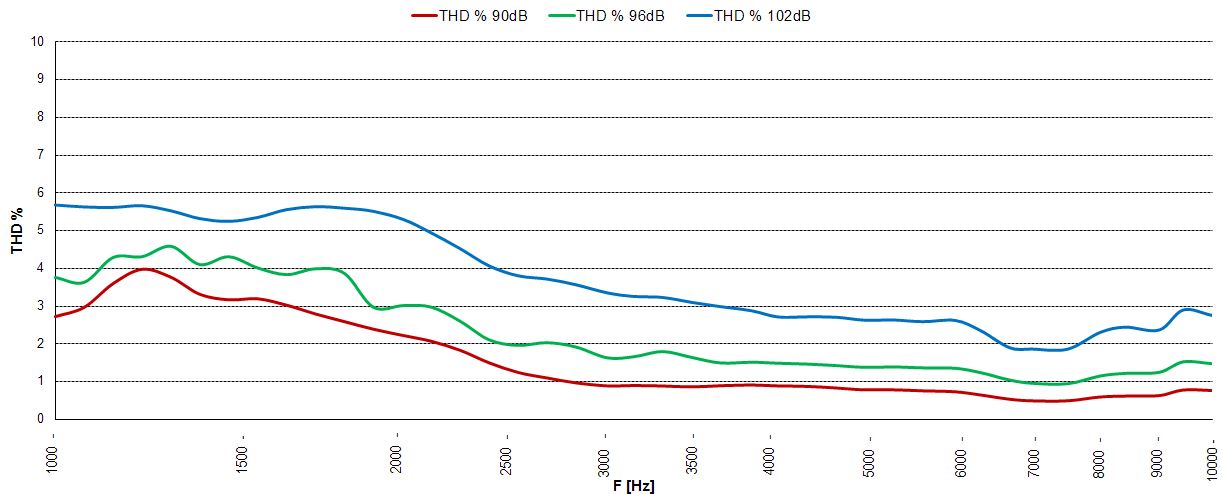
Source: https://www.dibirama.altervista.org/
Total harmonic distortion (THD) is the term for unwanted signal distortion. Distortion is heard as an added overtone to some instrument notes making these sound harsh. The source of harmonic distortion is the unwanted flexing of the tweeter dome. The measure of distortion is usually done using a single sine wave though this is not representative of music. Both charts give THD variation with sound pressure level (SPL). As volume increases THD increases. This can be seen in both charts as separate plots for 90dB SPL, 96dB and 102dB. The THD profile is slightly worse for the DT-99 compared to the DT-300 but there is not a lot in it. For both tweeters at 90dB, distortion is about 0.7% from about 3000Hz.
Intermodulation distortion is not measured by total harmonic distortion (THD) but they tend to occur together. As the number of instruments reproduced increases the dome will attempt to play these and this may cause tweeters to flex and sound suffers. Here the separation between instruments may be lost and individual instruments will lose tone and detail. Further treble hardens and artifacts are heard and orchestral music definition will be lost. Going loud and/or increasing the number of instruments played both increase intermodulation distortion. If you don't listen to orchestral, congested or choral music and you don't play loud then distortion, in either the DT-99 or DT-300, will not be an issue.
Sound Pressure Level (SPL) by Frequency
Figure 2: Sound Pressure Level (SPL) plot by Frequency for two Monacor tweeter drivers - Half-space frequency response (2.83V-1m) DT-300 DT-99
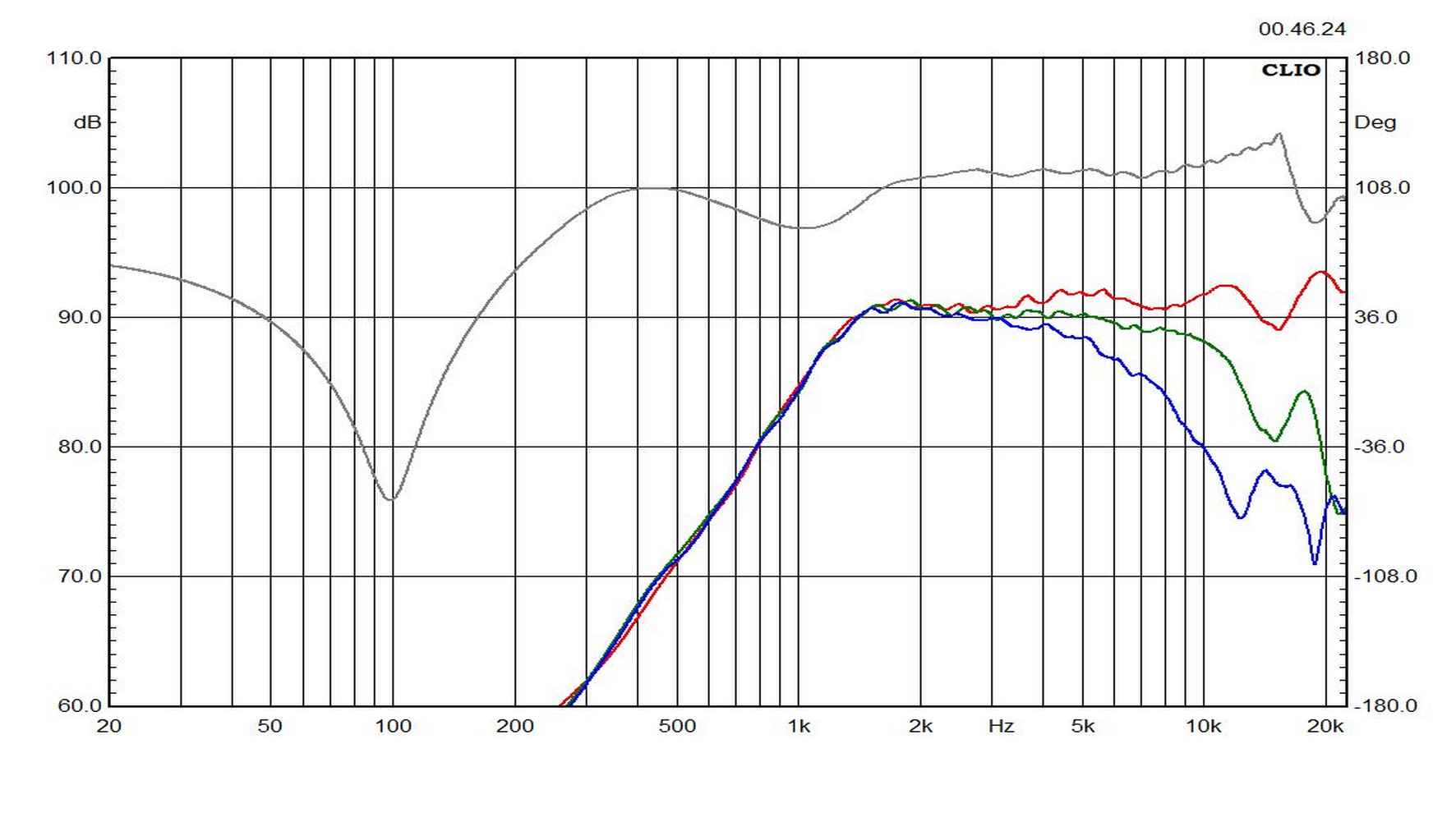
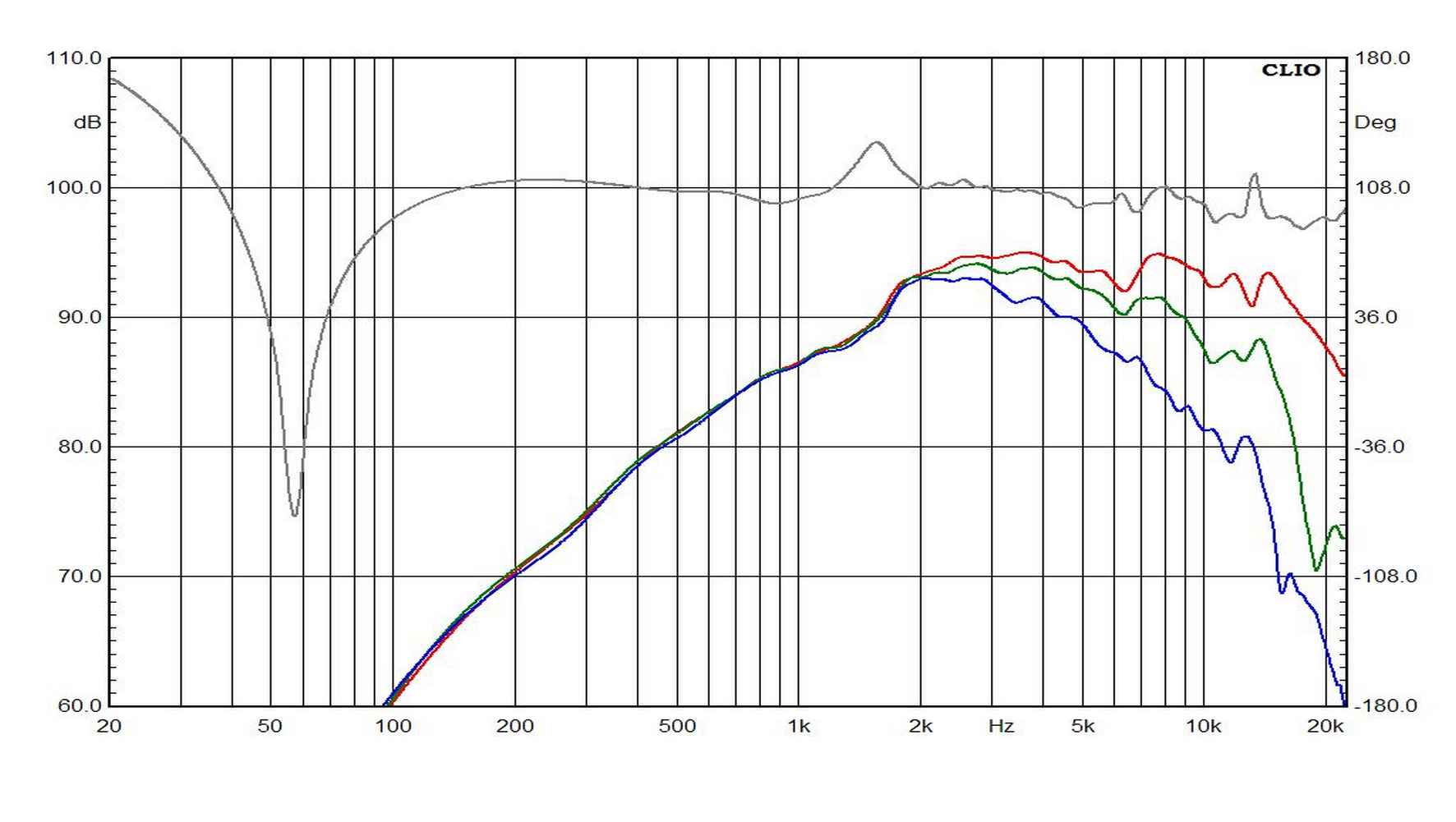
Source: https://www.dibirama.altervista.org/
Figure 2 sound pressure level (SPL) by frequency says something about how tweeter output sound level varies by frequency; in an ideal world, the speaker would output a flat SPL line over its operating frequency range. SPL level by frequency is often presented smoothed by moving averages and these charts may not give an accurate picture of the highs and lows actually heard. Monacor rates both drives at 93dB. Three SPL frequency lines are given. The higher one gives the SPL for on axis listening, and the other two off-axis listening at 60 degrees and 30 degrees off axis. The SPL variations by frequency of the DT-99 look difficult with an on axis SPL rise at 13kHz followed by a dip of sound level at 15kHz and a subsequent rise at 17kHz. There is not much difference in the spread of SPL between the two tweeters.
BT-99 Crossover
If you construct your DT-99 crossover assuming SPL is a flat 93dB there will be treble grating with playback as top octave sound pressure will be higher and the sound will be top octave strong. Also this will sound distorted as the higher SPL sound will be distorted. You want to avoid this. This tweeter could do with at least one notch filter starting at 9kHz to 15kHz and possibly a second one between 5kHz and 7kHz. A two notch filter could make for a difficult crossover design for this tweeter. Though one DT-99 user said they just fitted a gargantuan L-pad of 5/ 10 ohm. The site also describes an L-pad attenuated crossover for the DT-99.
I am currently using an A25/Zu speaker copy. This lets the woofer run free over the drivers frequency range and just fits a capacitor on the tweeter. My preferred crossover point is about 9kHz. Zu crossovers handle rising SPL on the tweeter by just moving the tweeters crossover point higher and letting the crossovers capacitor, as a variable resistor, handle the reduction of SPL below the crossover point. So long as the tweeters SPL falls sufficiently by the time that it audibly crosses the woofer (88dB) it should be fine. With the DT-99 I raised the crossover first to 13kHz and then to 14kHz and finally to about 16kHz. At 13kHz the tweeter was fed with too much high frequency energy and this dominated the sound and in addition this sound was distorted, 14kHz was a little better and most material was listenable though some very top octave piano notes were distorted and highest violin notes had little tone . With an electrical crossover of about 16kHz, a point just above the DT-99 SPL peak ending at 15kHz, almost all material was listenable even solo piano was free of artifacts.
DT-99 Modifications
The DT-99 sounds rough, it has an untidy ragged high octave performance but it does give a raw emotional connection with the music. I listen to a lot of top octave instruments and I needed to dial back the raw ragged nature of this tweeter. To meet this I applied watered-down PVA craft glue but one layer only and limited to a spot on the crown of the silk dome. The idea here is that the damped crown corrects the delay of sound between the center and dome edge. However doping will also impact on dome flexing and help to disperse the break up of energy. When doing this I felt that I had over-watered down the PVA glue and overapplied the mixture. I attempted to clear some of the over-application by cleaning the silk dome area above the inner edge with a cue-tip doused in squeezed out water. I did this twice. I also added another layer of felt to the solid pole piece. Doping the dome had more of an impact than adding another layer of damping. Increasing the doped dot size seemed to increase tone and damp the DT-99 treble behaviour but this reduced detail and flow, and instrument realisation suffered. Reducing the doped dot size reduced tone but increased openness, detail and instrument definition.
Listening DT-99
For a crossover I found using a warm capacitor worked better for my taste with the DT-99. I tried a number of alternative warm capacitor mixes and found that a CrossCap mix worked slightly better playing high octave violins. The capacitor mix played high octave piano Adams and Riley
(Cheng-Cochran playing) with a nice near felt hammer dulled overtones. And the pace was good and the soundscape held together well with some insight into the playing. The top octave was not exposed and there was no treble grating and had an engaging musical flow. The pace playing Solo Piano
(Takemitsue) was good and this CD was very listenable as was String Quartets
(Gavin Brayers). Playing complex orchestra pieces, however, played below par. Orchestra sounded weak with poor dynamics, and were presented with confusion, as instruments were melded together and there was a loss of detail. In general the best point about the DT-99 is its captivating musical listen but only for ensemble playing up to about a dozen musicians; here the tweeter captures a vividness and presenting, at times, a nearly live musical experience.
DT-300 Modifications
There are two known modifications to the DT-300 the first removes the ferro fluid and redamps the hole in the pole piece and damps the hole surround and the second modification adds a purpose built waveguide. Instruction and results of the first modifications are given here and here. Details of the waveguide are given here and here. I fitted both. I did not find so much difference in played music by removing the ferro fluid and changing damping and I regret making this modification. Adding the waveguide, however, was a leap change in sound.
There are two waveguide options for the DT-300 available on the market, the pricey, at least in the UK, WG-300, is a Monacor made waveguide. There is also the less expensive WGX-300, also made for the DT-300, but made by P-Audio. I fitted the P-Audio waveguide. Note using the P-audio PCT-300 tweeter would make this speaker waveguide bundle that much less expensive. A DIY waveguide can be found here .
Adding the Waveguide
Adding a waveguide controls directivity. It smooths out the DT-300 SPL above about 11kHz and increases SPL in the mid and lower register frequency treble region.
Waveguides reduce off-axis sound pressure, and that means less surface, or at least shorter, reflections and less room reflections should be heard. Also a reduced spread of sound waves should mean less intermodulation distortion and a reduction of any potential comb effect issues. There should be less sound wave interruption between the tweeter and mid/bass woofer and better sound integration between drivers. And also there is no faceplate hence less surface diffraction. Further there is more acoustic amplification due to the waveguide fit, which accounts for the SPL rise, but this means the tweeter can achieve a similar SPL with lower dome movement and that means less distortion. There should be a cleaner and better composed sound stage with a waveguide.
The first time I heard the DT-300 with a waveguide it nerved me, I thought I was losing dynamics and pace. Pace was down but this seemed only noticeable with slow music. Using a Solen FastCap mix of three capacitors (400v) for the crossover. Playing String Quartets
(Gavin Bryars, Balanescu Quartet), the modified speaker and waveguide combination turned this piece into an unlistenable lament. Similarly, playing Solo Piano
(Takemitsu, Paul Crossley) came across as boring and unlistenable. To attempt to meet this pace issue I paralleled a greater number of low voltage capacitors. In the end I used a mid-quality, Bevenbi, 100v polyester but a 250v polypropylene should work just as well. The pace of Takemitsu
and Gavin Bryars
were now playable. What this does indicate is that the DT-300 w/waveguide has mild pace issues and if pace is important to you then this tweeter might not work for you.
With the waveguide, violin tone and reverb were better and generally presentation was more than just a straightforward reproduction. Listening to Adams and Riley
(Cheng-Cochran), the top octave notes reproduction did have satisfying dull overtones, though the sound was spoiled by a slight ringing or stridency when passages became complex. Piano music was reproduced as if with a human touch and was very listenable. Playing complex orchestra pieces, Corpus Cum Figuris
(Ruders), the DT-300 w/waveguide kept up with the dynamic swings and kept both tension, detail and musicality flowing. There was some thinness to instruments. But in all it added up to a listenable performance. Feria
(Linderg) also played without issue and seemed to have more instrument tone than usual. There are enough background instruments that are picked out here and this added to the listening experience. With small ensembles, and given recording, the DT-300 w/waveguide did imaging well with good back to front and sideways instrument spacing. Though this was not so apparent for solo and orchestral pieces.
An issue with the DT-300/waveguide is that some content is played, in the top octave, as if played in a hollow and had echoes. This was more noticeable with solo piano and less for large ensembles. This echo sound is not dominant and gives some content a slightly rounded presentation that could come across as adding to tone or as part of the recording microphone placement. I'm now used to the sound.
With the DT-300 w/waveguide, using the Philips CD753 player fitted with the LME49723, there was little treble harshness or spotlighting and the treble range was, in the main, good. And the tweeter played every genre of material in the high frequency fine; opera, solo, ensemble, percussion, brass, strings and orchestral music. It delivers an unexpected orchestra sound with fullness, instrument detail and shows orchestral dynamics off well. For orchestra the tweeter sounds unphased in the face of the onslaught of massed instruments and reproduces crescendos with seemingly little or no issues. Also mid range top octave separation and tone is good and i'm liking the detail. I could live with the Monacor DT-300 with P-Audio waveguide, and polyester capacitor set up.
Conclusion
First the DT-99. What I like about the DT-99 is its immediacy, unpretentiousness and an ability to play with musicality. Sometimes it's as if you are nearly there listening to the music live. Though using warm capacitors, Jantzen CrossCap (400v), and you'll need to do this, did dial the emotion back. High octave violins are well presented and generally there is instrument tone. The tweeter does have SPL and distortion linearity problems and this makes speaker crossover design difficult. And the sound will be different depending on the crossover used and if an L-Pad is fitted.
Doping treatment to the dome crown and adding felt or a foam diffraction ring, and diffraction treatment to surrounding surfaces, did help with SPL frequency linearity. The tweeter will not suit everyone and the DT-99 can't be played loud and does not play orchestral music well. The tweeter was best playing solo, small and mid sized ensemble music. The tweeter worked, for me, with a minimalist capacitor, Zu type, crossover that is pushed high to handle SPL frequency variations. Compared to other tweeters I found the DT-99 more musical and had better sound flow that emotionally engages the listener with a lot of music. Unmodified it sounded less sophisticated, untamed with a less controlled instrument sound in the top octave but it was engaging delivering an andrealen soaked sound. If you are willing to work within the DT-99 constraints and live with its limitations then it may work for you.
The DT-300 w/waveguide plays music in an unrushed way. Capacitor crossover selection may be important as high voltage rated polypropylene capacitors seem to slow down some slow material to the point of being boring and uninteresting. Pace may be mildly off with this tweeter. There is also a question of a hint of hollowness, as if the speaker is played in a hollow and if this is a sound signature of waveguides. Compared to the DT-99 the DT-300, with waveguide, had more detail and tone for top octave instruments, played orchestral music better and had better imaging with small ensemble playing while the modified DT-99 played solo and some mid sized ensemble music better and had better in your face pace. But saying that I could probably not tell the tweeters apart for some solo and small ensemble music. Both drivers are limited but in different ways. The DT-99 doesn't play orchestral music and that's important to me, the DT-300 is fine for all genres, and plays most music without issues thopugh there is the pace issue.
The DT-300 is much the same cost as the DT-99. However adding the waveguide adds about half as much again to cost. Both tweeters come up regularly on auction sites.
DISCLAIMER. TNT-Audio is a 100% independent magazine that neither accepts advertising from companies nor requires readers to register or pay for subscriptions. If you wish, you can support our independent reviews via a PayPal donation. After publication of reviews, the authors do not retain samples other than on long-term loan for further evaluation or comparison with later-received gear. Hence, all contents are written free of any “editorial” or “advertising” influence, and all reviews in this publication, positive or negative, reflect the independent opinions of their respective authors. TNT-Audio will publish all manufacturer responses, subject to the reviewer's right to reply in turn.
![[Donate with Paypal!]](../gif/donate_now.gif)
![[Find us on Facebook!]](../jpg/fb_small.jpg)
© 2023 TNT-Audio Paul Hunting - paul@tnt-audio.com - www.tnt-audio.com
[ Home TNT-Audio | Staff & Contacts | HiFi Playground | Listening tests | DIY & Tweakings | Music & Books ]






![[Donate with Paypal!]](../gif/donate_now.gif)
![[Find us on Facebook!]](../jpg/fb_small.jpg)